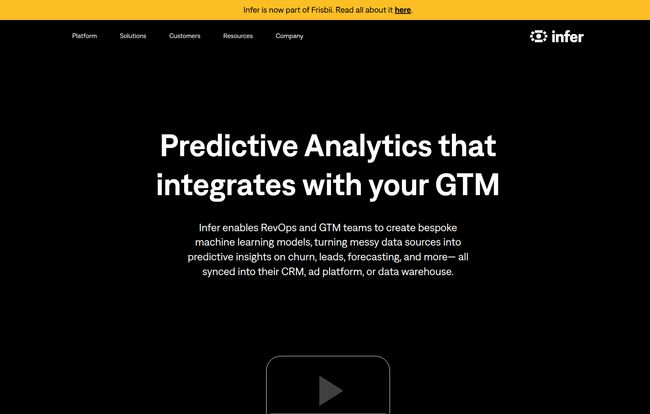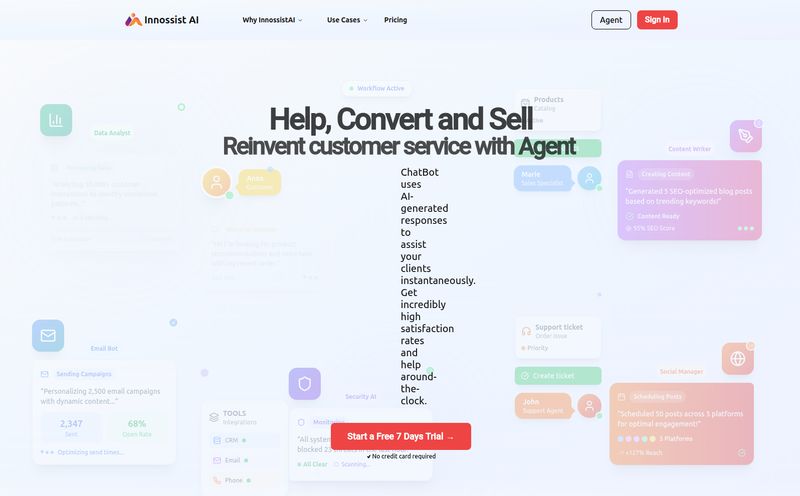Tired of a Crystal Ball That Only Shows You the Past?
For years, we've been obsessed with being “data-driven.” We've built massive data warehouses, hired brilliant analysts, and generated more dashboards than we know what to do with. And yet, for most of us, all that data is just a really detailed rearview mirror. It’s great at telling us what happened last quarter. But what about next quarter?
Predictive analytics has always been the holy grail. The thing that separates the teams that react from the teams that lead. But it's also been this walled garden, guarded by data scientists with PhDs and complex Python libraries. If you wanted to know which leads were hot or which customers were a churn risk, you’d file a ticket and wait. And wait.
I've been in that boat, and frankly, it's frustrating. So when I stumbled across a platform called Infer, my interest was piqued. Their whole pitch is about putting predictive power directly into the hands of the people who already know the data best: the analysts. And they do it through a language many of us already speak fluently—SQL.

Visit Infer
That’s a bold claim. So, is it just another fancy dashboard with some AI sprinkled on top, or is it genuinely something different? I decided to dig in.
So What is Infer, Exactly?
At its heart, Infer is an AI layer that sits on top of your existing data stack. It’s not trying to be your new CRM or your new data warehouse. It’s designed to plug right in and enhance what you’ve already got. The core idea is to let RevOps (Revenue Operations) and GTM (Go-to-Market) teams build and run their own machine learning models without leaving their SQL editor.
Think about that for a second. No more exporting CSVs to a separate modeling tool. No more trying to translate business questions into a language data scientists understand. It's a pretty compelling idea.
And it seems I'm not the only one who thinks so. I saw this quote on their site and it stopped me in my tracks:
“The infer tool is amazing – with a single SQL line you can create an entire bespoke machine learning model.”
- Iina Ioana Blidaru, Head of Data & Strategy @ Google
When someone with a title like that at Google says something is amazing, you pay attention. It suggests this isn't just smoke and mirrors. It's a tool built for serious practitioners.
The Real Magic: Bringing Machine Learning into SQL
The biggest hurdle to adopting ML in most companies isn't a lack of data; its the operational gap. The analyst who understands the business context of churn doesn't know how to build a gradient-boosting model. The data scientist who can build the model doesn't have the deep, intuitive business context.
Infer aims to be the bridge. It works by extending SQL with simple commands. Instead of just writing SELECT FROM customers, you can effectively write a query that asks, “SELECT FROM customers AND PREDICT their likelihood_to_churn.”
This is a game-changer. It's like giving your SQL analyst a super power. They can now explore, find patterns, and build predictive models all in one workflow. This turns the data analysis process from a historical report into a forward-looking strategy session.
What Can You Actually Do With It?
- Smarter Lead Scoring: Stop relying on simple metrics like job titles. Infer can analyze all the subtle signals in your data to predict which leads are most likely to convert, allowing your sales team to focus their energy where it counts.
- Proactive Churn Prediction: Identify at-risk customers before they cancel. By understanding the leading indicators of churn, you can create targeted retention campaigns that actually work.
- Accurate Forecasting: Move beyond simple trend lines. Infer can help you build more nuanced forecasts that account for seasonality, market changes, and complex customer behaviors.
- Data-Driven Storytelling: This is a feature I find particularly interesting. Infer doesn’t just spit out numbers; it helps you build a narrative around them with automated visualizations and insights. It finds the “so what?” for you, which is often the hardest part.
Meet Your New AI Coworker
One of the standout features mentioned is something they call “Coworker AI.” This isn’t just another chatbot. The idea is that it works alongside your analyst, automatically generating visualizations and surfacing insights you might have missed. It’s a second pair of eyes on your data, constantly looking for patterns and correlations.
This is where I see massive potential for efficiency gains. How much time do analysts spend just trying different chart types to see what sticks? If an AI can do that initial heavy lifting and present the most interesting angles, your human team can focus on the higher-level strategic thinking. It’s about augmenting intelligence, not replacing it.
Who is This Really For?
Let's be clear: this probably isn't a tool for the marketing intern who has never seen a database. The website and the entire premise are geared towards teams that have a certain level of data maturity. You need to have your data in a reasonably organized place (like Snowflake, BigQuery, Redshift, etc.) and you need people who are comfortable with SQL.
But for those teams—RevOps, GTM, data analytics, and business intelligence—this could be huge. It democratizes machine learning within the organization, speeding up the time from question to insight from weeks to minutes. It’s for the people who are tired of being bottlenecked by data science resources and want to get their hands dirty.
The Potential Gotcha
The reliance on SQL is both a strength and a potential weakness. If your team is full of SQL wizards, they'll be up and running in no time. If your team lives exclusively in Excel and GUI-based tools, there will be a learning curve. That's not a flaw in the tool itself, just a reality of who its built for. Its a tool for builders.
What's the Price Tag?
Ah, the million-dollar question. Or, hopefully, a bit less. Like many enterprise-grade B2B SaaS platforms, Infer doesn’t list its pricing publicly on the website. Instead, you'll see the familiar “Book A Demo” button.
While I always prefer transparent pricing, this is pretty standard practice. It usually means pricing is customized based on factors like:
- The size of your database
- The number of users
- The specific integrations you need
My advice? Don’t let the lack of a price tag scare you off if the tool sounds like a fit. A demo is a great way to see if it can solve a real, costly problem for you. If it can help you reduce churn by just a few percentage points or improve lead conversion, it could pay for itself very quickly.
My Final Thoughts on Infer
I’ve seen a lot of tools come and go. Most make big promises, but fall short in the execution. Infer feels different. By building on the solid foundation of SQL and focusing on a specific, high-value problem, they've created something that feels both powerful and practical.
It's not a magic button. You still need to understand your business and your data. But it is a powerful catalyst. It takes the esoteric world of machine learning and makes it an accessible, everyday tool for the people on the front lines of business growth.
If you're a data-savvy team looking to move from simply reporting on the past to actively shaping the future, Infer is absolutely worth a look. It might just be the tool that finally lets your data live up to its full potential.
Frequently Asked Questions
- 1. What is Infer in simple terms?
- Infer is an AI platform that lets you run predictive machine learning models using simple SQL commands. It's designed to help business teams (like sales and marketing) predict things like customer churn or which sales leads are best, all without needing a separate data science team.
- 2. Do I need to be a data scientist to use Infer?
- No, but you do need to be comfortable with SQL. The platform is built for data analysts, RevOps professionals, and others who already work with data using SQL. It makes ML accessible to them, but it's not a no-code tool for complete beginners.
- 3. How does Infer integrate with my current tools?
- It's designed to connect directly to your existing data stack. It integrates with major data warehouses like Snowflake, Google BigQuery, and Amazon Redshift, and can sync its insights back into your CRM or advertising platforms.
- 4. Is Infer only for large enterprise companies?
- While it's clearly powerful enough for enterprises (as shown by their customers and the Google testimonial), its value is more about data maturity than company size. A mid-sized startup with a strong data culture could get immense value from it. The best way to know is to request a demo.
- 5. Why isn't the pricing for Infer listed on the website?
- This is common for specialized B2B software. Pricing is likely tailored to each customer based on their data volume, number of users, and specific needs. You'll need to schedule a demo with their sales team to get a custom quote.
- 6. What makes Infer different from other BI tools like Tableau or Power BI?
- While BI tools are excellent for visualizing existing data and exploring what has happened, Infer is focused on predicting what will happen. It's a predictive analytics platform, not just a business intelligence and reporting tool. It builds ML models directly within your workflow.
Reference and Sources
- Infer Official Website
- What is RevOps? - RevOps.io (For context on the target user)



